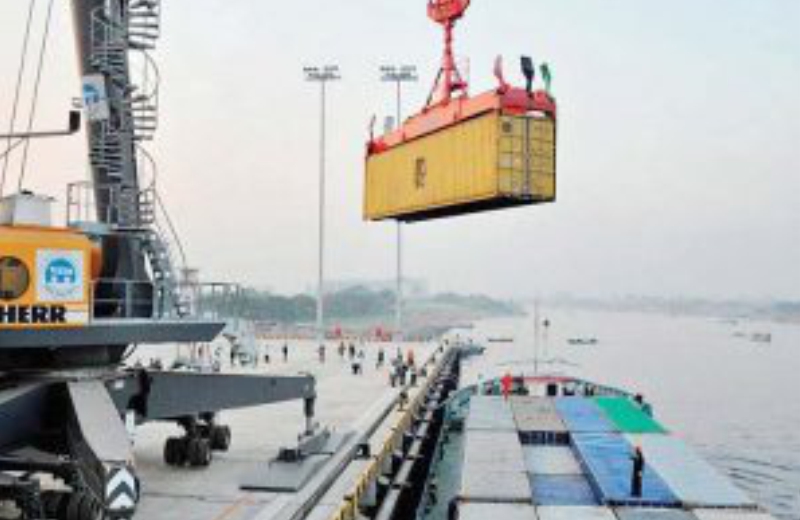September 29, 2020: Watch the containers to see which way the economic winds will blow. How many are ordered, for when and for how much. And if you do, you’ll see that box demand is strong — not just through year-end, but into 2021.
Three of the largest container-equipment lessors — Triton (NYSE: TRTN), Textainer (NYSE: TGH) and CAI International (CAI) — conducted virtual presentations for institutional investors over the past week, hosted by Keefe, Bruyette & Woods (KBW). Notes on those presentations provided to FreightWaves by KBW paint a rosy picture of consumer demand.
According to one theory, U.S. import volume is so high today because shippers are bringing orders forward. Volumes will start tapering off soon and moderate through year-end.
This doesn’t seem to jibe with what the container-equipment lessors are seeing.
“Triton expects to see sustained heightened activity through the fourth quarter, while demand could remain strong through the Chinese New Year [in mid-February 2021],” reported KBW.
A handful of producers in China build almost all of the world’s containers. “At this point, factories are now full through January and are taking orders for February and March delivery,” KBW said, reporting on Triton’s presentation.
“Based on indications from customers [shipping lines], demand looks like it is going to continue into the first quarter,” speakers said in the Textainer and CAI presentations.
Liners caught short
Container lines own a portion of their container portfolio and rent the rest from box-equipment lessors.
One of the key takeaways from the Triton presentation was that “the surprising strength in trade meant that shipping lines were structurally short on containers.”
Compounding the capacity crunch, lessors noted that due to “changes in labor regulations [in China], the manufacturers are limited to one shift per day, effectively capping production levels.”
That is not welcome news for liners and cargo shippers facing mounting container shortages.
Shift in consumption
Triton pointed to “the ongoing strength of the consumer and the shift in consumption away from services and experiences into goods, particularly anything related to the home.”
Shippers transport lighter cargoes such as consumer goods in 40-foot containers. They ship heavier cargoes such as raw materials in 20-footers. Triton noted that the 40-foot sector “is the tightest portion of the market.” Its own portfolio is now at nearly 100% utilization. In contrast, the 20-foot segment, more prevalent in the intra-Asian raw-materials trades, is softer.
Demand has been so strong that box-equipment lessors will be protected even if there is a COVID second wave and “the recent upswing fizzles out,” said KBW.
“Due to the strength of the recent upswing, the lessors have been able to lease out nearly all containers under demand — namely 40-foot high cubes — on favorable terms for multi-year contracts.”
High demand is hiking the price of new containers. They are now at $2,200 per cost equivalent unit (CEU) versus $1,800 earlier this year. (CEU expresses the value of a container as a multiple of a 20-foot dry cargo unit.)
“If demand is sustained, prices could push higher following Chinese New Year,” KBW added.
Lease rates paid by liner companies have also improved, albeit not as much as they could have. Triton said that it “could push pricing [higher] to boost returns, but given that business is tied to seven to eight main shipping lines, management feels the short-term benefit is not worth the risk to long-term relationships.”
A better bellwether
It takes around two years to build a ship, but only six to eight weeks to build a new box. This makes it less likely for box supply to outstrip demand than ship supply. The box market can more easily self-correct.
“Lessors are typically wary of placing orders too far out as the exposure to movements in steel prices is risky,” wrote KBW. “This caution keeps order and production cycles short.”
Michael Webber, founder of Webber Research & Advisory, highlighted the significance of box-equipment lessors as a more general bellwether.
“These [box-equipment lessor] stocks offer a better real-time gauge of what’s actually happening from a trade perspective and they’re closer as a real-time indicator to the container lines themselves,” he said during an interview with FreightWaves. “I tend to look at the box-lessor stocks as the best gauge.”
“It’s also a very tradeable group,” said Webber. “You can actually make money trading this group by having a fundamental thesis and having that thesis play out. That is not always the case.”
Positive signal
Box-equipment lessor stocks should be trading on next year’s outlook, not 2020, he continued. People have already placed bets “on the back half of the year,” said Webber. “Now we’re talking about what 2021 and what a return to normalcy looks like.”
Source: Hellenic Shipping








